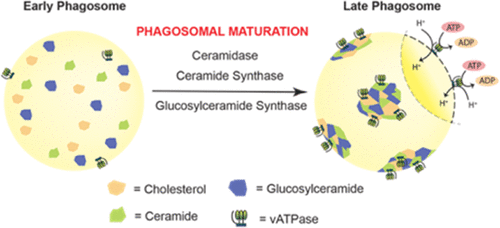当前位置:
X-MOL 学术
›
ACS Chem. Biol.
›
论文详情
Our official English website, www.x-mol.net, welcomes your
feedback! (Note: you will need to create a separate account there.)
Mapping Sphingolipid Metabolism Pathways during Phagosomal Maturation
ACS Chemical Biology ( IF 3.5 ) Pub Date : 2021-10-14 , DOI: 10.1021/acschembio.1c00393 Neelay Mehendale 1 , Roop Mallik 2 , Siddhesh S Kamat 1
ACS Chemical Biology ( IF 3.5 ) Pub Date : 2021-10-14 , DOI: 10.1021/acschembio.1c00393 Neelay Mehendale 1 , Roop Mallik 2 , Siddhesh S Kamat 1
Affiliation

|
Phagocytosis is an important physiological process, which, in higher organisms, is a means of fighting infections and clearing cellular debris. During phagocytosis, detrimental foreign particles (e.g. pathogens and apoptotic cells) are engulfed by phagocytes (e.g. macrophages), enclosed in membrane-bound vesicles called phagosomes, and transported to the lysosome for eventual detoxification. During this well-choreographed process, the nascent phagosome (also called early phagosome, EP) undergoes a series of spatiotemporally regulated changes in its protein and lipid composition and matures into a late phagosome (LP), which subsequently fuses with the lysosomal membrane to form the phagolysosome. While several elegant proteomic studies have identified the role of unique proteins during phagosomal maturation, the corresponding lipidomic studies are sparse. Recently, we reported a comparative lipidomic analysis between EPs and LPs and showed that ceramides are enriched on the LPs. Further, we found that this ceramide accumulation on LPs was orchestrated by ceramide synthase 2, inhibition of which hampers phagosomal maturation. Following up on this study, here, using biochemical assays, we first show that the increased ceramidase activity on EPs also significantly contributes to the accumulation of ceramides on LPs. Next, leveraging lipidomics, we show that de novo ceramide synthesis does not significantly contribute to the ceramide accumulation on LPs, while concomitant to increased ceramides, glucosylceramides are substantially elevated on LPs. We validate this interesting finding using biochemical assays and show that LPs indeed have heightened glucosylceramide synthase activity. Taken together, our studies provide interesting insights and possible new roles of sphingolipid metabolism during phagosomal maturation.
中文翻译:

在吞噬体成熟期间绘制鞘脂代谢途径
吞噬作用是一个重要的生理过程,在高等生物中,它是对抗感染和清除细胞碎片的一种手段。在吞噬作用期间,有害的外来颗粒(例如病原体和凋亡细胞)被吞噬细胞(例如巨噬细胞)吞噬,包裹在称为吞噬体的膜结合囊泡中,然后转运到溶酶体进行最终解毒。在这个精心设计的过程中,新生吞噬体(也称为早期吞噬体,EP)在其蛋白质和脂质组成中经历了一系列时空调节的变化,并成熟为晚期吞噬体(LP),随后与溶酶体膜融合形成吞噬溶酶体。虽然几项优雅的蛋白质组学研究已经确定了独特蛋白质在吞噬体成熟过程中的作用,相应的脂质组学研究很少。最近,我们报道了 EP 和 LP 之间的比较脂质组学分析,并表明神经酰胺在 LP 上富集。此外,我们发现 LPs 上的这种神经酰胺积累是由神经酰胺合酶 2 协调的,其抑制会阻碍吞噬体的成熟。跟进这项研究,在这里,使用生化分析,我们首先表明 EP 上增加的神经酰胺酶活性也显着有助于神经酰胺在 LP 上的积累。接下来,利用脂质组学,我们证明 跟进这项研究,在这里,使用生化分析,我们首先表明 EP 上增加的神经酰胺酶活性也显着有助于神经酰胺在 LP 上的积累。接下来,利用脂质组学,我们证明 跟进这项研究,在这里,使用生化分析,我们首先表明 EP 上增加的神经酰胺酶活性也显着有助于神经酰胺在 LP 上的积累。接下来,利用脂质组学,我们证明从头合成神经酰胺不会显着促进 LPs 上的神经酰胺积累,而伴随着神经酰胺的增加,葡糖神经酰胺在 LPs 上显着升高。我们使用生化分析验证了这一有趣的发现,并表明 LP 确实具有增强的葡糖神经酰胺合酶活性。总之,我们的研究提供了有趣的见解和鞘脂代谢在吞噬体成熟过程中可能的新作用。
更新日期:2021-12-17
中文翻译:

在吞噬体成熟期间绘制鞘脂代谢途径
吞噬作用是一个重要的生理过程,在高等生物中,它是对抗感染和清除细胞碎片的一种手段。在吞噬作用期间,有害的外来颗粒(例如病原体和凋亡细胞)被吞噬细胞(例如巨噬细胞)吞噬,包裹在称为吞噬体的膜结合囊泡中,然后转运到溶酶体进行最终解毒。在这个精心设计的过程中,新生吞噬体(也称为早期吞噬体,EP)在其蛋白质和脂质组成中经历了一系列时空调节的变化,并成熟为晚期吞噬体(LP),随后与溶酶体膜融合形成吞噬溶酶体。虽然几项优雅的蛋白质组学研究已经确定了独特蛋白质在吞噬体成熟过程中的作用,相应的脂质组学研究很少。最近,我们报道了 EP 和 LP 之间的比较脂质组学分析,并表明神经酰胺在 LP 上富集。此外,我们发现 LPs 上的这种神经酰胺积累是由神经酰胺合酶 2 协调的,其抑制会阻碍吞噬体的成熟。跟进这项研究,在这里,使用生化分析,我们首先表明 EP 上增加的神经酰胺酶活性也显着有助于神经酰胺在 LP 上的积累。接下来,利用脂质组学,我们证明 跟进这项研究,在这里,使用生化分析,我们首先表明 EP 上增加的神经酰胺酶活性也显着有助于神经酰胺在 LP 上的积累。接下来,利用脂质组学,我们证明 跟进这项研究,在这里,使用生化分析,我们首先表明 EP 上增加的神经酰胺酶活性也显着有助于神经酰胺在 LP 上的积累。接下来,利用脂质组学,我们证明从头合成神经酰胺不会显着促进 LPs 上的神经酰胺积累,而伴随着神经酰胺的增加,葡糖神经酰胺在 LPs 上显着升高。我们使用生化分析验证了这一有趣的发现,并表明 LP 确实具有增强的葡糖神经酰胺合酶活性。总之,我们的研究提供了有趣的见解和鞘脂代谢在吞噬体成熟过程中可能的新作用。











































 京公网安备 11010802027423号
京公网安备 11010802027423号